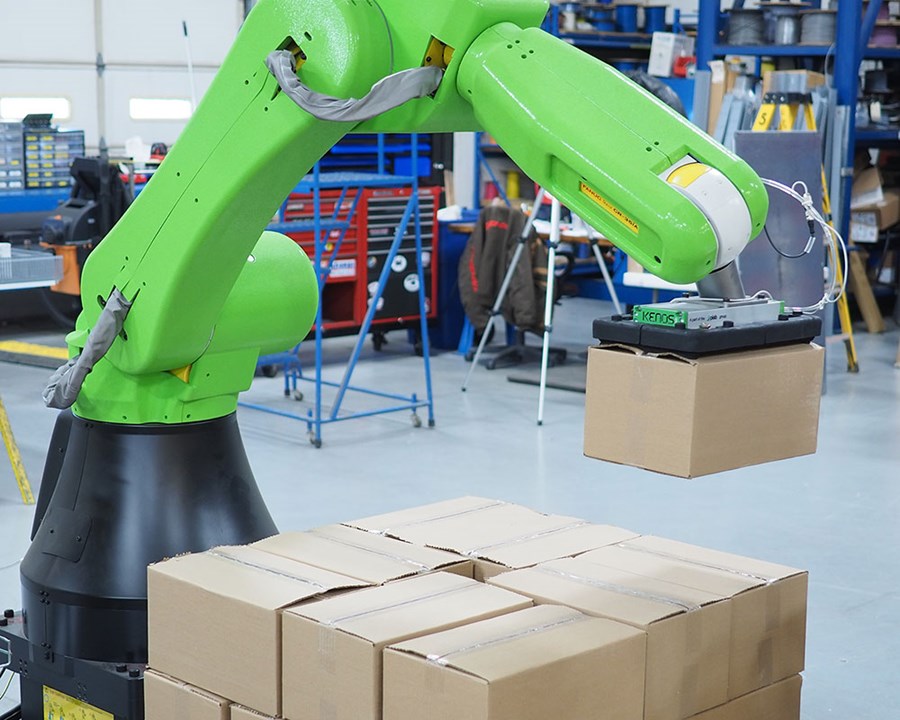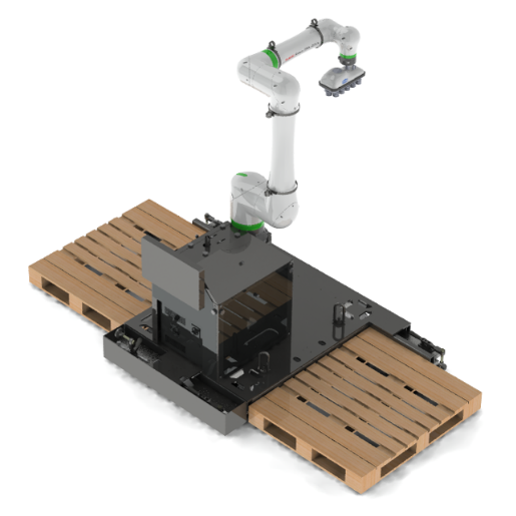
Warehouse Robots: Are Collaborative Robotic Palletizers the Best Fit for Your Application?
Christian Willis | 11 December 2024
Once companies decide to automate their warehouses or manufacturing facilities, choosing the technology can be an exciting step in the process. Which leading-edge equipment could be implemented? The possibilities seem almost endless.
When it comes to traditional robotics, most companies start by looking at collaborative robots, or cobots, which makes sense. Space is often tight in facilities, so having a robot that can work right alongside a person seems like the most efficient solution. However, many companies are quick to invest in a cobot without conducting the necessary pre-engineering analysis to determine if it is truly the most suitable solution. It’s critical to not only consider human interaction, but also throughput demands, product specifications and building layouts.
The Difference Between Cobots and Industrial Robots
The main difference between a collaborative robot and an industrial robot comes down to their design and purpose. Cobots are built to work safely around people, with force sensors and slower speeds to minimize the risk of injury. Because of these built-in safety features, cages and barriers aren’t typically needed. On the other hand, industrial robots are all about speed and power. They run faster, handle heavier payloads and are designed for high-volume production, but they do need safety enclosures to keep workers protected. Cobots shine when it comes to flexibility and ease of use, whereas industrial robots are built for serious heavy lifting and quick movements.
The Good and the Not-So-Good About Collaborative Palletizers
One of the biggest perks of cobot solutions is that their safety features are integrated, so when operating at slow speeds, cobots don’t typically require additional safety equipment. If running at faster speeds, all that would be required is one or two area scanners to track people flow, still keeping infrastructure at a minimum.
Another benefit is that if your workflow changes, reprogramming the robot is very simple and intuitive. Most collaborative robots are designed to be on an easy to move platform. If the system ever needs to be relocated, you can easily use a forklift to lift the cobot stand and move it to its new position with minimal effort. When moving an industrial robot, there’s a lot more components that need to be disconnected and rewired. This could be a very expensive and time-consuming process.
But there’s a tradeoff: because cobots are built to be safe and work without barriers, they tend to move pretty slowly. For instance, Bastian Solutions StackOrder™ (our standard collaborative palletizing system), collaborative speeds are typically around 2-3 cycles per minute (with faster rates available). Whereas, when an industrial robot is incorporated, rates can increase to 3-8 cycles per minute. Another downside is their limited payload capacity. In the StackOrder cell, the maximum weight a cobot can handle is around 45 lbs., which is fine for lighter products but not ideal for heavier items.
Figure 1: Bastian Solutions StackOrder(TM) Palletizer
 |
On the bright side, while industrial robots might come with a lower base price, cobot solutions can be more budget-friendly overall since you don’t need to add things like light curtains or fencing.
The Pros and Cons of Industrial Robots
Before deciding on a cobot, it’s worth taking a close look at what industrial robots offer.
A big advantage of industrial robots is that they can handle much heavier loads. Depending on the model, they can carry 3-4 times more weight than cobots. This is a game-changer because you can move multiple items at once, boosting your productivity.
Speed is another factor. Industrial robots can move faster, often achieving about 6 cycles per minute, depending on the setup. When you combine speed and payload capacity, industrial robots can often handle up to four times more products than a cobot.
Of course, all that power and speed means you need to invest in safety measures like light curtains, scanners and fencing, which add to the cost and require more space. In fact, when you factor in the safety setup, an industrial palletizing solution can take up nearly twice the space of a collaborative solution like Bastian Solutions StackOrder.
Which Warehouse Robotic Solution is Right for You?
Deciding between a cobot and an industrial robot comes down to your specific needs. If space is tight, your products are light and your budget is tighter, a cobot might be the way to go. But if you need higher throughput, can handle a bigger budget and have room for safety barriers, an industrial robot could be the better fit. Still questioning which solution is right for you? Reach out to one of our robotics experts today to get personalized recommendations for your application.
Christian Willis is an Application Engineer with the Robotics group of Bastian Solutions in St. Louis, MO since 2023. He has a Bachelor of Science in Mechanical Engineering from Purdue University Northwest. Before Bastian, Christian worked with a different robotic integrator who specialized in custom robotic solutions. As an application engineer, Christian works with customers to design and integrate automated solutions for their material handling needs in manufacturing, distribution, and logistics.
Comments
No comments have been posted to this Blog Post
Leave a Reply
Your email address will not be published.
Comment
Thank you for your comment.